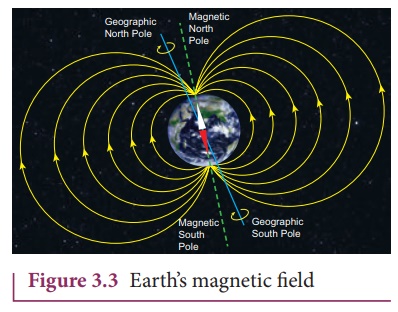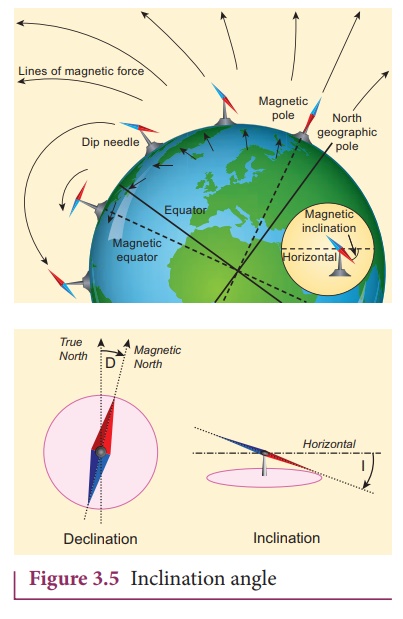Chapter: 12th Physics : Magnetism and Magnetic Effects of Electric Current
EarthŌĆÖs magnetic field and magnetic elements
EarthŌĆÖs magnetic field and magnetic elements
From the activities performed in lower classes, we have noticed that the needle in a magnetic compass or freely suspended magnet comes to rest in a position which is approximately along the geographical north-south direction of the Earth. William Gilbert in 1600 proposed that Earth itself behaves like a gigantic powerful bar magnet.

But this theory is not successful because the temperature inside the Earth is very high and so it will not be possible for a magnet to retain its magnetism.
Gover suggested that the EarthŌĆÖs magnetic field is due to hot rays coming out from the Sun. These rays will heat up the air near equatorial region. Once air becomes hotter, it rises above and will move towards northern and southern hemispheres and get electrified. This may be responsible to magnetize the ferromagnetic materials near the EarthŌĆÖs surface. Till date, so many theories have been proposed. But none of the theory completely explains the cause for the EarthŌĆÖs magnetism.
The north pole of magnetic compass needle is attracted towards the magnetic south pole of the Earth which is near the geographic north pole (Figure 3.3). Similarly, the south pole of magnetic compass needle is attracted towards the geographic north pole of the Earth which is near magnetic north-pole. The branch of physics which deals with the EarthŌĆÖs magnetic field is called Geomagnetism or Terrestrial magnetism.![]()
![]()
There are three quantities required to specify the magnetic field of the Earth on its surface, which are often called as the elements of the EarthŌĆÖs magnetic field. They are
(a) magnetic declination (D)
(b) magnetic dip or inclination (I)
(c) the horizontal component of the EarthŌĆÖs magnetic field (BH)

Day and night occur because Earth spins about an axis called geographic axis. A vertical plane passing through the geographic axis is called geographic meridian and a great circle perpendicular to EarthŌĆÖs geographic axis is called geographic equator.
The straight line which connects magnetic poles of Earth is known as magnetic axis. A vertical plane passing through magnetic axis is called magnetic meridian and a great circle perpendicular to EarthŌĆÖs magnetic axis is called magnetic equator.
When a magnetic needle is freely suspended, the alignment of the magnet does not exactly lie along the geographic meridian as shown in Figure 3.4. The angle between magnetic meridian at a point and geographical meridian is called the declination or magnetic declination (D). At higher latitudes, the declination is greater

The angle subtended by the EarthŌĆÖs total magnetic field ![]() with the horizontal direction in the magnetic meridian is called dip or magnetic inclination (I) at that point (Figure 3.5). For Chennai, inclination angle is 14o 16ŌĆÖ. The component of EarthŌĆÖs magnetic field along the horizontal direction in the magnetic meridian is called horizontal component of EarthŌĆÖs magnetic field, denoted by BH.
with the horizontal direction in the magnetic meridian is called dip or magnetic inclination (I) at that point (Figure 3.5). For Chennai, inclination angle is 14o 16ŌĆÖ. The component of EarthŌĆÖs magnetic field along the horizontal direction in the magnetic meridian is called horizontal component of EarthŌĆÖs magnetic field, denoted by BH.
Let BE be the net EarthŌĆÖs magnetic field at a point P on the surface of the Earth. BE can be resolved into two perpendicular components.

(i) At magnetic equator
The EarthŌĆÖs magnetic field is parallel to the surface of the Earth (i.e., horizontal) which implies that the needle of magnetic compass rests horizontally at an angle of dip, I = 0o as shown in figure 3.6.
BH = BE
BV = 0
This implies that the horizontal component is maximum at equator and vertical component is zero at equator.
(ii) At magnetic poles
The EarthŌĆÖs magnetic field is perpendicular to the surface of the Earth (i.e., vertical) which implies that the needle of magnetic compass rests vertically at an angle of dip, I = 90┬║ as shown in Figure 3.7. Hence,

BH = 0
BV = BE
This implies that the vertical component is maximum at poles and horizontal component is zero at poles.
EXAMPLE 3.1
The horizontal component and vertical components of EarthŌĆÖs magnetic field at a place are 0.15 G and 0.26 G respectively. Calculate the angle of dip and resultant magnetic field.
Solution:
BH = 0.15 G and BV = 0.26 G
tan I = 00.26/0.15 ŌćÆ I = tan ŌłÆ1(1. 732) =60┬║
The resultant magnetic field of the Earth is

Related Topics